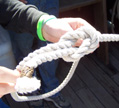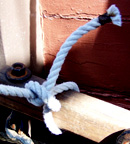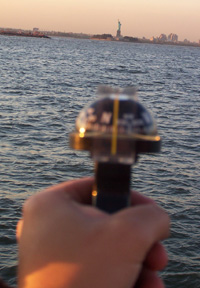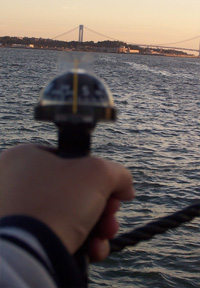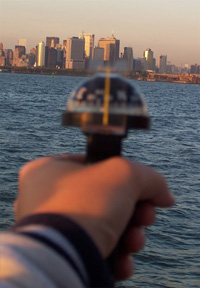 |
|
|
|
|
Quicklinks Task Matrix |
|
First Leg Shipcraft | Second Leg Shipcraft During our Voyages of Discovery, we maintain and operate the Half Moon much like Captain Hudson and his crew would have during their venture to the New World in 1609. Our student crew members spend a week fully immersed in 17th century ship life. Handling any given aspect of the Half Moon can require -- and teach -- a range of different skills. |
|
Task MatrixThe Matrix is how we track the activities our student crew members have completed dring their time on board. These activities include use of the shipcraft skills shown on this page, taking readings for their river science projects, and successfully performing ship's duties, such as taking the helm, standing lookout, or monitoring the safety of the ship through fire & bilge inspections.
Our crew members typically consider it a point of pride to complete as many tasks as they can -- and as the Matrix photos here prove, they were certainly up to the challenge. |
|
Line HandlingThe first thing any new crew member needs to do upon boarding a sailing ship is to literally "learn the ropes." However, handling a ship like the Half Moon can seem like quite a challenge. After all, this ship utilizes miles of rope (or "lines"), and each line serves a specific purpose. Handling a single sail may mean mastering a dozen separate lines. That said, these seemingly intimidating feats actually boil down to a series of very simple tasks. Thus, mastering the Half Moon begins with just a few basic skills: coiling a rope and tying a knot. When our students first come on board, we teach them how to properly belay and coil a line. (You can see Alex S. and Amro practicing their belaying to the left.) To belay a line is to securely lash it to a belaying pin on the pin rail, so that it will not slip loose on its own, but can be quickly removed if need be. Properly coiling ropes reduces wear on the lines and keeps the deck tidy, which keeps the lines from snagging on each other or tripping the crew. |
|
Once a crew member knows how to coil and belay a line, he or she can proceed to the next step in mastering line handling: Learning knots. Experienced sailors might know literally dozens of different knots, each with its own specific uses. However, a typical crew member can get along just fine (and qualify for the task Matrix) by learning just three: the square knot, the half hitch, and the bowline (shown above, left to right). The Colleys take particular delight in teaching (and learning) new knots. |
|
Sail HandlingNow that our new crew is familiar with the running rigging, they can put their skills to use and operate the sails. First, the students learn a basic principle: Before you tug on any line, make sure you know what it's attached to and what pulling on it will do. As you can see in the photos here, knowing exactly where a line leads is sometimes far from obvious. |
|
The dozens of lines in our sailing ship's running rigging combine forces to operate the Half Moon not unlike a giant marionette. It takes a lot of hands to handle the sails, and thus a lot of cooperation. Our students quickly picked up the necessary skills, allowing us to set sail for a few hours on our first day of the voyage. When the winds favor us , our students split into two mast teams (one for the fore mast, another works the main mast). The mast teams must coordinate their efforts to effectively steer and propel the ship while under sail. (Unlike Captain Hudson and his men, who were often at the mercy of the winds, we also have a diesel engine to fall back on.) At the end of our first day, our adult crew climbs aloft to furl the sails, which means to wrap and bind the sails to that rain will not collect in them and winds will not grab them. Once our student crew members qualify to climb the rig, they'll be able to participate in furling and unfurling the sails as well. |
|
Working in the RigIn the sail handling photos above, you can see black, ladderlike rigging to either side of the masts. This is the standing rigging, and is designed not to move, as opposed to the running rigging, which is attached to moving parts. The thick, upright lines are called the shrouds, while the thinner, horizontal lines (the "ladder rungs") are called the ratlines. In the 17th century, this rigging would have been tarred to stiffen and weatherproof it, but today, we just use acrylic paint. (It works just as well, without the mess of tar.) The shrouds help stabilize the masts, and we also use them like ladders to climb aloft. Our crew climbs to the mast tops (historically, the term crow's nest would not have been used on the original ship) for many different reasons, from working the top sails to performing scientific experiments. Sometimes we even need to climb to the top of the mast just to retrieve a snagged flag. Climbing the rig isn't for everyone. Those heights can be daunting -- when in the mast top, you're standing about 60 feet above the weather deck -- so it isn't for everyone. No one is required to climb the rig, and it's entirely possible to be a valued member of the crew without having your feet ever leave the deck. However, most crew members consider it a significant accomplishment to reach the mast top, so even many crew members who are initially wary of heights end up overcoming their anxiety and going aloft by the end of the voyage. Working in the rig is one of the most exciting tasks on board the Half Moon, but it also carries the highest risk of injury. Thus, to keep everyone safe, we adhere to rigid safety codes. First, everyone who joins our crew must learn how to properly use a safety harness, even if they don't intend to climb. Once a crew member can correctly don a harness, he or she can climb out onto the channels or head up into the rigging for the next step (with adult supervision, of course). To the above left, you can see Nate learning how to correctly buckle his harness. You can also see more photos in the Daily Log. |
|
Once the crew pass their harness test, they then process to the shrouds to learn the principles of three-point contact. When climbing in the rig, a crew member must maintain three secure points of contact at all times (either both hands and a foot, or both feet and a hand). This way, just in case a climber's hand or foot does slip, he or she will still have two points of contact left to prevent a fall. Of course, maintaining three points of contact only leaves one hand free to clip a crew member's safety line into the rigging, so the new crew must also practice clipping and unclipping single-handedly, as you can see the students doing to the right. Only using one hand for your safety line isn't hard; it's remembering to only use one hand that can be tricky. |
|
Once crew members demonstrate that they've mastered the use of a safety harness, will obey the three points of contact rule, and pass a hang test, they are at last free to climb out onto the channels or even go aloft (with adult supervision), either to perform scientific experiments or to work the top sails. |
|
Once the students know how to read a chart, they can learn how to use lines of position to accurately estimate our location. Our layover in New York Harbor presented us with countless useful landmarks. |
|
For example, in these three photos, our deckhand is using a compass to sight the direction of the Statue of Liberty (almost due north), the western tower of the Verrazano-Narrows Bridge (almost due south), and the Empire State Building (to our northeast). He could then find these three known landmarks on a chart and use these three bearings to triangulate our current position in the harbor. |
|
Fortunately, our cook does have some help (not to mention a modern galley). The student crew takes turns acting as Mrs. Bardos's assistant as part of their regular crew roster, giving them an rapid introduction to the logistical challenges of keeping an entire ship's crew fed on time. |
|
